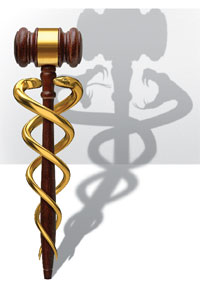CQ WEEKLY – COVER STORY
June 16, 2012 – 2:01 p.m.
The Fights After the Fight
By CQ Staff
Only seven minutes after President Obama signed the Patient Protection and Affordable Care Act into law on March 23, 2010, conservatives sued to overturn it in a federal court in Pensacola, Fla. That lawsuit, along with two related challenges, is now in the hands of the Supreme Court, where a ruling on all three cases — and, in turn, the future of the president’s most prized legislative achievement — is expected by the end of the month.

|
||
|
And regardless of the outcome, it will probably be even fewer than seven minutes between the court’s ruling and the start of the next rounds of this battle: in Congress, in lower courts and in the court of public opinion. On Capitol Hill and in the states, both parties are gaming out the various scenarios and their respective responses.
If the court strikes down the whole law, lawmakers will have to decide whether to reinstate the parts of it that are popular with the public. If it takes out only the law’s mandate that every individual buy health insurance, they will have to figure out how to manage a law whose main pillar has been extracted. And even if the court upholds the whole thing, the law will continue to be a political flash point — and a legal one. Many of the court challenges that have dogged the law since the first minutes of its existence will not simply disappear, as some lower court cases that have been on hold pending the outcome of the Supreme Court’s review are expected to resume, even in the event of a victory for Obama. While many such lawsuits would be dismissed because they make the same arguments as the big case, others might remain viable because they take on the law from different, albeit far narrower, legal angles.
The authors of the law, of course, structured it around the individual mandate, and in the process the authors won the support of the insurance industry, which will get 16 million additional customers if it remains intact. But that mandate is at the heart of the challengers’ arguments against it, and the justices indicated during the March oral arguments in the case that they were acutely aware of the ramifications, economic and political, of a decision to remove that provision as the underpinning element of the law. Overturning the complete entity, as opposed to its individual provisions, is a choice, as Justice
In other words, unless they uphold the entire law, the justices essentially will be dismantling Congress’ handiwork completely, or, at the very least, sending it back for further revision.
“There is no way that this court’s decision is not going to distort the congressional process,” Justice
The answer, said Deputy Attorney General Edwin S. Kneedler, arguing on behalf of the Obama administration, is judicial restraint. He argued that if the court rules against the mandate, it should take with it only the requirements that people with pre-existing conditions have access to coverage and that premiums are set without regard to the health status of the insured.
But there is also the view that simply overturning a big law with lots of provisions is less “activist” than selective editing, a process in which the end result might be an animal that looks wholly different from what Congress envisioned.
“We would be exercising the judicial power if . . . one provision was stricken and the others remained to impose a risk on insurance companies that Congress had never intended. By reason of this court, we would have a new regime that Congress did not provide for, did not consider,” said Justice
That’s a telling statement, since it comes from one who is regarded as a potential swing vote on the court. Conventional wisdom, in fact, holds that with this court, a split decision, and even a splintered one, is a safe bet. Yet there are those who believe the court may go out of its way to avoid a 5-4 split at a time of rife political polarization in America, and at a time when the court’s own public approval rating is slipping. A New York Times/CBS poll earlier this month showed that just 44 percent of Americans approve of the way the Supreme Court is doing its job and that 76 percent thought personal or political views sometimes influenced the high court’s decisions. The justices may want to show this time that their court is the one institution in Washington that is able to rise above the polarization.
If any issue is capable of eluding consensus, however, it’s health care. And even if the nine members of the Supreme Court find a way to agree, the rest of Washington probably will not.
What follows is a look at the strategy and positioning of the stakeholders in the event of various outcomes: a decision to overturn the law only partially, a complete rejection of the law, and a decision to uphold it.